weight SKODA SUPERB 2007 1.G / (B5/3U) Owner's Manual
[x] Cancel search | Manufacturer: SKODA, Model Year: 2007, Model line: SUPERB, Model: SKODA SUPERB 2007 1.G / (B5/3U)Pages: 259, PDF Size: 14.71 MB
Page 5 of 259
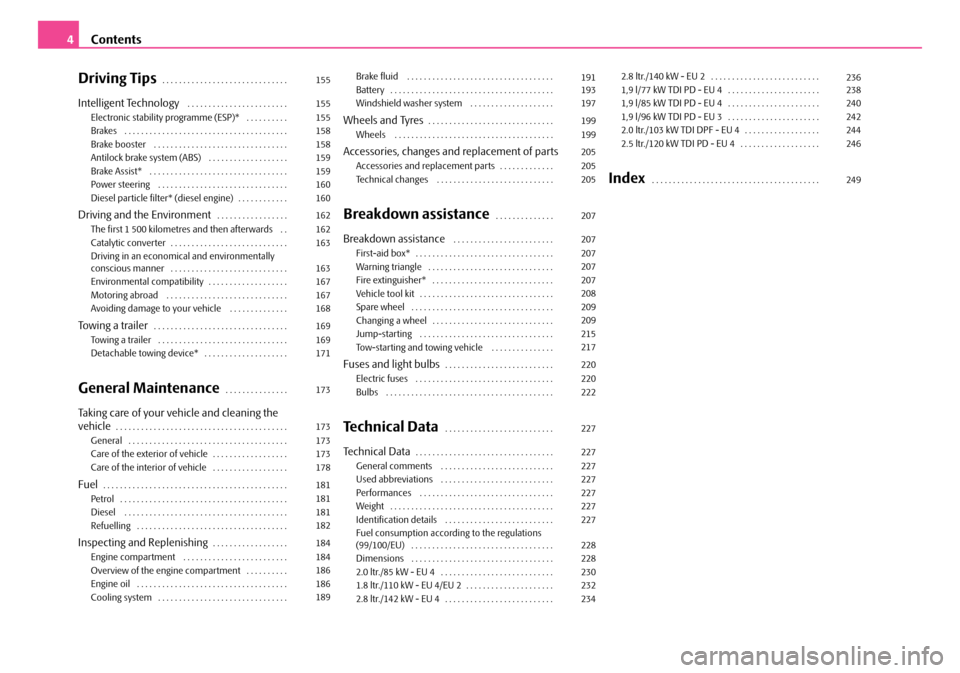
Contents
4
Driving Tips. . . . . . . . . . . . . . . . . . . . . . . . . . . . . .
Intelligent Technology . . . . . . . . . . . . . . . . . . . . . . . .
Electronic stability programme (ESP)* . . . . . . . . . .
Brakes . . . . . . . . . . . . . . . . . . . . . . . . . . . . . . . . . . . . . . .
Brake booster . . . . . . . . . . . . . . . . . . . . . . . . . . . . . . . .
Antilock brake system (ABS) . . . . . . . . . . . . . . . . . . .
Brake Assist* . . . . . . . . . . . . . . . . . . . . . . . . . . . . . . . . .
Power steering . . . . . . . . . . . . . . . . . . . . . . . . . . . . . . .
Diesel particle filter* (diesel engine) . . . . . . . . . . . .
Driving and the Environment. . . . . . . . . . . . . . . . .
The first 1 500 kilometres and then afterwards . .
Catalytic converter . . . . . . . . . . . . . . . . . . . . . . . . . . . .
Driving in an economical and environmentally
conscious manner . . . . . . . . . . . . . . . . . . . . . . . . . . . .
Environmental compatibility . . . . . . . . . . . . . . . . . . .
Motoring abroad . . . . . . . . . . . . . . . . . . . . . . . . . . . . .
Avoiding damage to your vehicle . . . . . . . . . . . . . .
To w i n g a t r a i l e r. . . . . . . . . . . . . . . . . . . . . . . . . . . . . . . .
Towing a trailer . . . . . . . . . . . . . . . . . . . . . . . . . . . . . . .
Detachable towing device* . . . . . . . . . . . . . . . . . . . .
General Maintenance. . . . . . . . . . . . . . .
Taking care of your ve hicle and cleaning the
vehicle. . . . . . . . . . . . . . . . . . . . . . . . . . . . . . . . . . . . . . . . .
General . . . . . . . . . . . . . . . . . . . . . . . . . . . . . . . . . . . . . .
Care of the exterior of vehicle . . . . . . . . . . . . . . . . . .
Care of the interior of vehicle . . . . . . . . . . . . . . . . . .
Fuel. . . . . . . . . . . . . . . . . . . . . . . . . . . . . . . . . . . . . . . . . . . .
Petrol . . . . . . . . . . . . . . . . . . . . . . . . . . . . . . . . . . . . . . . .
Diesel . . . . . . . . . . . . . . . . . . . . . . . . . . . . . . . . . . . . . . .
Refuelling . . . . . . . . . . . . . . . . . . . . . . . . . . . . . . . . . . . .
Inspecting and Replenishing. . . . . . . . . . . . . . . . . .
Engine compartment . . . . . . . . . . . . . . . . . . . . . . . . .
Overview of the engine compartment . . . . . . . . . .
Engine oil . . . . . . . . . . . . . . . . . . . . . . . . . . . . . . . . . . . .
Cooling system . . . . . . . . . . . . . . . . . . . . . . . . . . . . . . . Brake fluid . . . . . . . . . . . . . . . . . . . . . . . . . . . . . . . . . . .
Battery . . . . . . . . . . . . . . . . . . . . . . . . . . . . . . . . . . . . . . .
Windshield washer system . . . . . . . . . . . . . . . . . . . .
Wheels and Tyres. . . . . . . . . . . . . . . . . . . . . . . . . . . . . .
Wheels . . . . . . . . . . . . . . . . . . . . . . . . . . . . . . . . . . . . . .
Accessories, changes and replacement of partsAccessories and replacement parts . . . . . . . . . . . . .
Technical changes . . . . . . . . . . . . . . . . . . . . . . . . . . . .
Breakdown assistance. . . . . . . . . . . . . .
Breakdown assistance . . . . . . . . . . . . . . . . . . . . . . . .
First-aid box* . . . . . . . . . . . . . . . . . . . . . . . . . . . . . . . . .
Warning triangle . . . . . . . . . . . . . . . . . . . . . . . . . . . . . .
Fire extinguisher* . . . . . . . . . . . . . . . . . . . . . . . . . . . . .
Vehicle tool kit . . . . . . . . . . . . . . . . . . . . . . . . . . . . . . . .
Spare wheel . . . . . . . . . . . . . . . . . . . . . . . . . . . . . . . . . .
Changing a wheel . . . . . . . . . . . . . . . . . . . . . . . . . . . . .
Jump-starting . . . . . . . . . . . . . . . . . . . . . . . . . . . . . . . .
Tow-starting and towing vehicle . . . . . . . . . . . . . . .
Fuses and light bulbs. . . . . . . . . . . . . . . . . . . . . . . . . .
Electric fuses . . . . . . . . . . . . . . . . . . . . . . . . . . . . . . . . .
Bulbs . . . . . . . . . . . . . . . . . . . . . . . . . . . . . . . . . . . . . . . .
Technical Data. . . . . . . . . . . . . . . . . . . . . . . . . .
Te c h n i c a l D a t a. . . . . . . . . . . . . . . . . . . . . . . . . . . . . . . . .
General comments . . . . . . . . . . . . . . . . . . . . . . . . . . .
Used abbreviations . . . . . . . . . . . . . . . . . . . . . . . . . . .
Performances . . . . . . . . . . . . . . . . . . . . . . . . . . . . . . . .
Weight . . . . . . . . . . . . . . . . . . . . . . . . . . . . . . . . . . . . . . .
Identification details . . . . . . . . . . . . . . . . . . . . . . . . . .
Fuel consumption according to the regulations
(99/100/EU) . . . . . . . . . . . . . . . . . . . . . . . . . . . . . . . . . .
Dimensions . . . . . . . . . . . . . . . . . . . . . . . . . . . . . . . . . .
2.0 ltr./85 kW - EU 4 . . . . . . . . . . . . . . . . . . . . . . . . . . .
1.8 ltr./110 kW - EU 4/EU 2 . . . . . . . . . . . . . . . . . . . . .
2.8 ltr./142 kW - EU 4 . . . . . . . . . . . . . . . . . . . . . . . . . . 2.8 ltr./140 kW - EU 2 . . . . . . . . . . . . . . . . . . . . . . . . . .
1,9 l/77 kW TDI PD - EU 4 . . . . . . . . . . . . . . . . . . . . . .
1,9 l/85 kW TDI PD - EU 4 . . . . . . . . . . . . . . . . . . . . . .
1,9 l/96 kW TDI PD - EU 3 . . . . . . . . . . . . . . . . . . . . . .
2.0 ltr./103 kW TDI DPF - EU 4 . . . . . . . . . . . . . . . . . .
2.5 ltr./120 kW TDI PD - EU 4 . . . . . . . . . . . . . . . . . . .
Index . . . . . . . . . . . . . . . . . . . . . . . . . . . . . . . . . . . . . . . .
155
155
155
158
158
159
159
160
160
162
162
163
163
167
167
168
169
169
171
173
173
173
173
178
181
181
181
182
184
184
186
186
189 191
193
197
199
199
205
205
205
207
207
207
207
207
208
209
209
215
217
220
220
222
227
227
227
227
227
227
227
228
228
230
232
234236
238
240
242
244
246
249
NKO B5 20.book Page 4 Friday, March 2, 2007 1:46 PM
Page 68 of 259
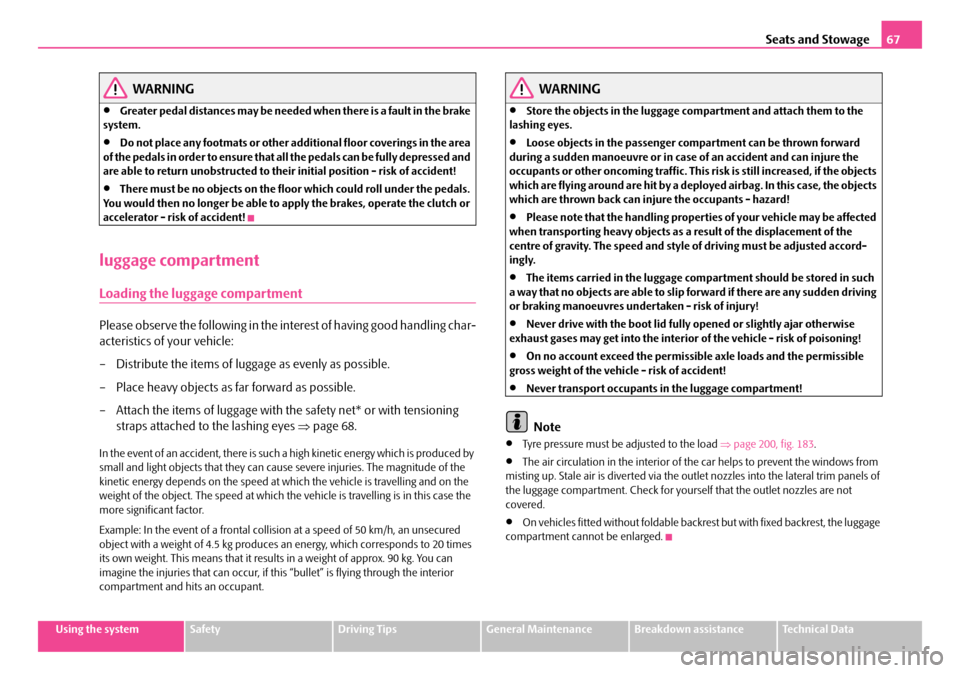
Seats and Stowage67
Using the systemSafetyDriving TipsGeneral MaintenanceBreakdown assistanceTechnical Data
WARNING
•Greater pedal distances may be needed when there is a fault in the brake
system.
•Do not place any footmats or other additional floor coverings in the area
of the pedals in order to ensure that all the pedals can be fully depressed and
are able to return unobstructed to their initial position - risk of accident!
•There must be no objects on the floor which could roll under the pedals.
You would then no longer be able to apply the brakes, operate the clutch or
accelerator - risk of accident!
luggage compartment
Loading the luggage compartment
Please observe the following in the inte rest of having good handling char-
acteristics of your vehicle:
– Distribute the items of luggage as evenly as possible.
– Place heavy objects as far forward as possible.
– Attach the items of luggage with th e safety net* or with tensioning
straps attached to the lashing eyes ⇒page 68.
In the event of an accident, there is such a high kinetic energy which is produced by
small and light objects that they can caus e severe injuries. The magnitude of the
kinetic energy depends on the speed at wh ich the vehicle is travelling and on the
weight of the object. The speed at which the vehicle is travelling is in this case the
more significant factor.
Example: In the event of a frontal collis ion at a speed of 50 km/h, an unsecured
object with a weight of 4.5 kg produces an energy, which corresponds to 20 times
its own weight. This means that it results in a weight of approx. 90 kg. You can
imagine the injuries that can occur, if this “bullet” is flying through the interior
compartment and hits an occupant.
WARNING
•Store the objects in the luggage compartment and attach them to the
lashing eyes.
•Loose objects in the passenger co mpartment can be thrown forward
during a sudden manoeuvre or in case of an accident and can injure the
occupants or other oncoming traffic. This risk is still increased, if the objects
which are flying around are hit by a deployed airbag. In this case, the objects
which are thrown back can injure the occupants - hazard!
•Please note that the handling properties of your vehicle may be affected
when transporting heavy objects as a result of the displacement of the
centre of gravity. The speed and style of driving must be adjusted accord-
ingly.
•The items carried in the luggage compartment should be stored in such
a way that no objects are able to slip forward if there are any sudden driving
or braking manoeuvres under taken - risk of injury!
•Never drive with the boot lid fully opened or slightly ajar otherwise
exhaust gases may get into the interior of the vehicle - risk of poisoning!
•On no account exceed the permissible axle loads and the permissible
gross weight of the vehicle - risk of accident!
•Never transport occupants in the luggage compartment!
Note
•Tyre pressure must be adjusted to the load ⇒page 200, fig. 183 .
•The air circulation in the interior of th e car helps to prevent the windows from
misting up. Stale air is diverted via the outlet nozzles into the lateral trim panels of
the luggage compartment. Check for yourself that the outlet nozzles are not
covered.
•On vehicles fitted without foldable back rest but with fixed backrest, the luggage
compartment cannot be enlarged.
NKO B5 20.book Page 67 Friday, March 2, 2007 1:46 PM
Page 70 of 259
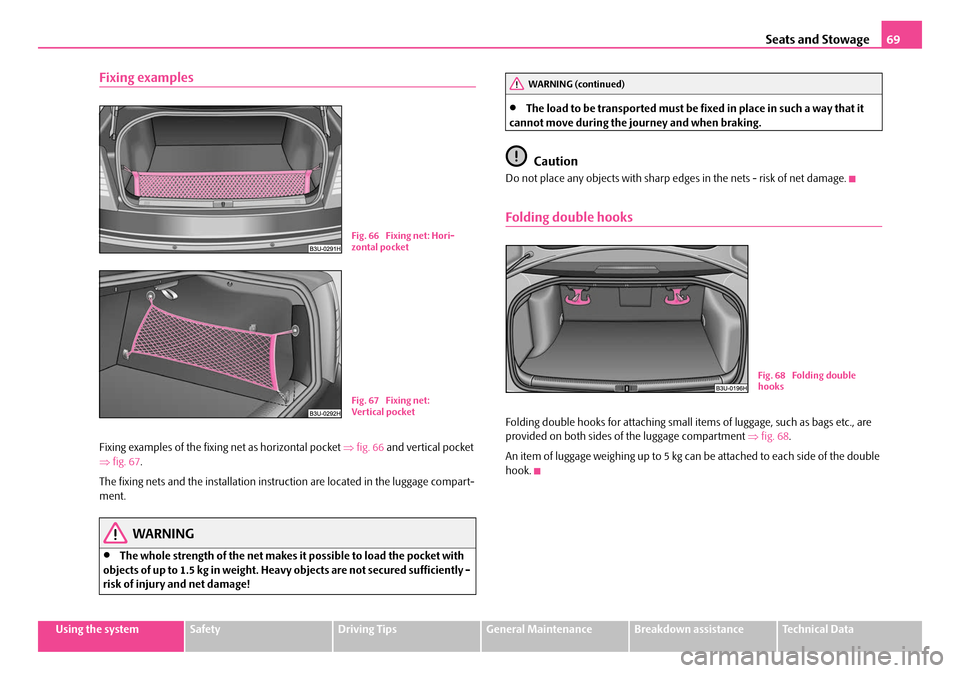
Seats and Stowage69
Using the systemSafetyDriving TipsGeneral MaintenanceBreakdown assistanceTechnical Data
Fixing examples
Fixing examples of the fixing net as horizontal pocket ⇒fig. 66 and vertical pocket
⇒ fig. 67 .
The fixing nets and the installation inst ruction are located in the luggage compart-
ment.
WARNING
•The whole strength of the net makes it possible to load the pocket with
objects of up to 1.5 kg in weight. Heavy objects are not secured sufficiently -
risk of injury and net damage!
•The load to be transported must be fixed in place in such a way that it
cannot move during the journey and when braking.
Caution
Do not place any objects with sharp edges in the nets - risk of net damage.
Folding double hooks
Folding double hooks for attaching small it ems of luggage, such as bags etc., are
provided on both sides of the luggage compartment ⇒fig. 68 .
An item of luggage weighing up to 5 kg can be attached to each side of the double
hook.
Fig. 66 Fixing net: Hori-
zontal pocket
Fig. 67 Fixing net:
Ver tical pocket
WARNING (continued)
B1Z-0042HB1Z-0042HFig. 68 Folding double
hooks
NKO B5 20.book Page 69 Friday, March 2, 2007 1:46 PM
Page 77 of 259

Seats and Stowage
76
Opening folding box
You can transport the opened folding box in the secured end or middle
position against the partition of the luggage compartment.
Opening folding box
– Lower the folding box into the ready position ⇒page 75.
– Press the button marked “PUSH” ⇒fig. 80 . – Grasp the folding box at the handle and push it in direction of
arrow 1 against the partition of the luggage compartment into the
secured position. The lock below the button must be heard to engage.
If correctly locked, the button mark ed “PUSH” moves back into its
initial position.
– Raise the lid in direction of arrow 2 ⇒ fig. 81 .
– Press on the bottom part of the handle and open the compart- ments in the direction of arrow 3. The compartment wall must be
heard to engage in the slot in the bottom part of the box.
Moving folding box into secured middle position
– Press on the button marked “PUSH” ⇒fig. 81 and carefully push
the folding box into the secured mi ddle position. If correctly locked,
the button marked “PUSH” is moved back into its initial position.
You can now use the space which ha s become available for stowing
further items of luggage.
Caution
•The parts of the folding box can be dama ged if handled roughly or in an unpro-
fessional way.
•The maximum weight of goods to be loaded should not exceed 25 kg.
B1Z-0042HB1Z-0042H
Fig. 80 Luggage
compartment: folding
box
B1Z-0042HB1Z-0042HFig. 81 Opening folding
box
AB
AA
AB
AC
AD
AD
NKO B5 20.book Page 76 Friday, March 2, 2007 1:46 PM
Page 79 of 259
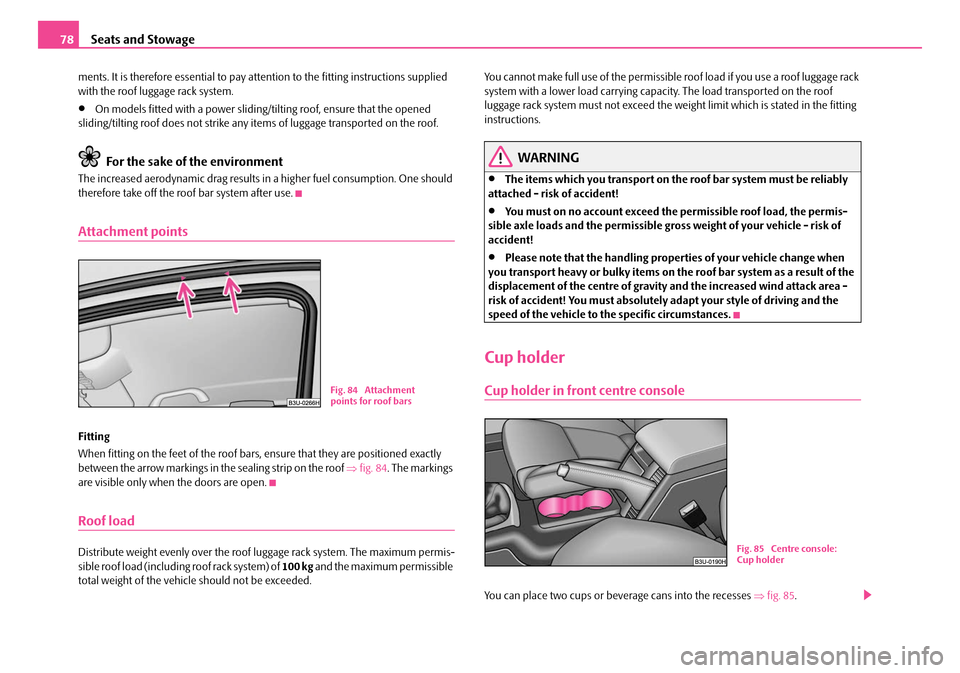
Seats and Stowage
78
ments. It is therefore essential to pay a ttention to the fitting instructions supplied
with the roof luggage rack system.
•On models fitted with a power sliding/tilting roof, ensure that the opened
sliding/tilting roof does not strike any items of luggage transported on the roof.
For the sake of the environment
The increased aerodynamic drag results in a higher fuel consumption. One should
therefore take off the roof bar system after use.
Attachment points
Fitting
When fitting on the feet of the roof bars, ensure that they are positioned exactly
between the arrow markings in the sealing strip on the roof ⇒fig. 84 . The markings
are visible only when the doors are open.
Roof load
Distribute weight evenly over the roof luggage rack system. The maximum permis-
sible roof load (including roof rack system) of 100 kg and the maximum permissible
total weight of the vehicl e should not be exceeded. You cannot make full use of the permissible
roof load if you use a roof luggage rack
system with a lower load carrying capa city. The load transported on the roof
luggage rack system must not exceed the weight limit which is stated in the fitting
instructions.
WARNING
•The items which you transport on the roof bar system must be reliably
attached - risk of accident!
•You must on no account exceed the permissible roof load, the permis-
sible axle loads and the permissible gros s weight of your vehicle - risk of
accident!
•Please note that the handling prop erties of your vehicle change when
you transport heavy or bulky items on the roof bar system as a result of the
displacement of the centre of gravity and the increased wind attack area -
risk of accident! You must absolutely adapt your style of driving and the
speed of the vehicle to the specific circumstances.
Cup holder
Cup holder in front centre console
You can place two cups or beverage cans into the recesses ⇒fig. 85 .
Fig. 84 Attachment
points for roof bars
B1Z-0042HB1Z-0042HFig. 85 Centre console:
Cup holder
NKO B5 20.book Page 78 Friday, March 2, 2007 1:46 PM
Page 107 of 259
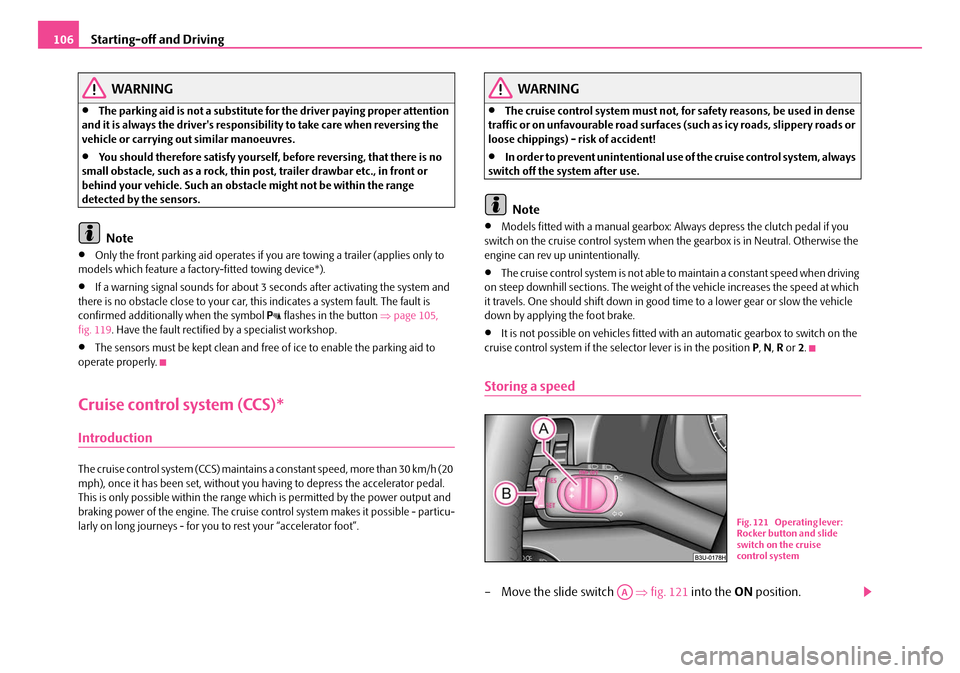
Starting-off and Driving
106
WARNING
•The parking aid is not a substitute fo r the driver paying proper attention
and it is always the driver's responsibility to take care when reversing the
vehicle or carrying out similar manoeuvres.
•You should therefore satisfy yourself, before reversing, that there is no
small obstacle, such as a rock, thin post, trailer drawbar etc., in front or
behind your vehicle. Such an obstacle might not be within the range
detected by the sensors.
Note
•Only the front parking aid operates if yo u are towing a trailer (applies only to
models which feature a factor y-fitted towing device*).
•If a warning signal sounds for about 3 seconds after activating the system and
there is no obstacle close to your car, th is indicates a system fault. The fault is
confirmed additionally when the symbol
flashes in the button ⇒page 105,
fig. 119 . Have the fault rectified by a specialist workshop.
•The sensors must be kept clean and free of ice to enable the parking aid to
operate properly.
Cruise control system (CCS)*
Introduction
The cruise control system (CCS) maintains a constant speed, more than 30 km/h (20
mph), once it has been set, without you having to depress th e accelerator pedal.
This is only possible within the range which is permitted by the power output and
braking power of the engine. The cruise control system makes it possible - particu-
larly on long journeys - for you to rest your “accelerator foot”.
WARNING
•The cruise control system must not, for safety reasons, be used in dense
traffic or on unfavourable road surfaces (such as icy roads, slippery roads or
loose chippings) - risk of accident!
•In order to prevent unintentional use of the cruise control system, always
switch off the system after use.
Note
•Models fitted with a manual gearbox: Always depress the clutch pedal if you
switch on the cruise control system when the gearbox is in Neutral. Otherwise the
engine can rev up unintentionally.
•The cruise control system is not able to maintain a constant speed when driving
on steep downhill sections. The weight of the vehicle increases the speed at which
it travels. One should shift down in good time to a lower gear or slow the vehicle
down by applying the foot brake.
•It is not possible on vehicl es fitted with an automatic gearbox to switch on the
cruise control system if the selector lever is in the position P, N , R or 2.
Storing a speed
– Move the slide switch ⇒fig. 121 into the ON position.
B1Z-0042HB1Z-0042H
Fig. 121 Operating lever:
Rocker button and slide
switch on the cruise
control system
AA
NKO B5 20.book Page 106 Friday, March 2, 2007 1:46 PM
Page 132 of 259

Seat belts131
Using the systemSafetyDriving TipsGeneral MaintenanceBreakdown assistanceTechnical Data
The physical principle of a frontal collision
The physical principle of a frontal a ccident can be explained quite simply:
Motion energy, so-called kinetic energy, is produced as soon as the vehicle is
moving, both for the vehicle and its occupants. The magnitude of this kinetic energy
depends essentially on the speed at which the vehicle is travelling and on the
weight of the vehicle and the occupants. The greater the speed and weight increase, the greater the amount of energy which has to be absorbed in the event of an acci-
dent.
The speed of the vehicle is, nevertheless,
the most important factor. Doubling the
speed of the vehicle from 25 km/h up to 50 km/h increases the kinetic energy four
times.
The common opinion that it is possible to support your body in a minor accident
with your hands, is incorrect. Even in a collision at only a low speed, the forces
acting on the body are such that it is no longer possible to support your body.
Even if you only drive at a speed within the range from 30 km/h to 50 km/h, the
forces which are produced on your body in the event of an accident can easily
exceed 10.000 N (Newton). This equals a weight of one tonne (1 000 kg).
In the event of a frontal collision, occupants of the car not wearing a seat belt, are
thrown forward and strike in an uncontrolle d way parts of the interior of the car,
such as steering wheel, dash panel, windscreen, ⇒fig. 138 . The occupants of a
vehicle who have not fastened their seat belts may even be thrown out of the
vehicle. This can resu lt in fatal injuries.
It is also important that rear seat occupants fasten their seat belts as they will other-
wise be thrown through the vehicle in an uncontrolled manner in the event of an
accident A rear seat passenger who has not fastened the seat belt is a danger not
only to himself but also fo r those seated at the front ⇒fig. 139 .
Important safety information regarding the use of
seat belts
The correct use of the seat belts considerably reduces the risk of
injury!
WARNING
•The belt webbing must not be jammed in-between at any point or
twisted, or chafe against any sharp edges.
•It is important that the belt webbing is properly routed if the seat belts
are to offer their maximum protection ⇒page 132, “How are seat belts
correctly fa stened?”.
Fig. 138 The driver is
thrown forward if not
wearing a belt
Fig. 139 The rear seat
occupant is thrown
forward if not wearing a
belt
NKO B5 20.book Page 131 Friday, March 2, 2007 1:46 PM
Page 147 of 259

Transporting children safely
146
Transporting children safely
What you should know about transporting children!
An introduction to the subject
Accident statistics have revealed that children are generally more
safely transported on the rear seat s than on the front passenger seat.
Children younger than 12 years of age should normally travel on the rear seat of the
vehicle (take note of any national legal pr ovisions which differ from this). They
should be secured there by means of a child restraint system or by using the existing
seat belts depending on their age, body si ze and weight. The child seat should be
mounted behind the front passen ger seat for safety reasons.
The physical principle of an accident does, of course, also apply to children
⇒ page 131, “The physical principle of a frontal collision”. They differ from adults in
that their muscles and bone structure of ch ildren are not yet fully developed. Thus
children are exposed to increased risk of injury.
Children should be transported by using special child safety seats in order to
reduce this risk of injury.
Use only child safety seats which are offici ally approved and are suitable for chil-
dren and which comply with the ECE-R 44 Standard, which classifies child safety
seats into 5 groups ⇒page 149, “Classification of child seats into groups”. Child
restraint systems which have been tested for conformity with ECE-R 44 have a non-
detachable test seal (a large E within a circle and below this the test number)
attached to the seat.
We recommend that you use child safety seats from the Škoda genuine accessories.
These child seats were developed and also tested for use in Škoda vehicles. They
fulfil the standard ECE-R 44.
WARNING
Always comply with national legal provisions and instructions from the rele-
vant child safety seat manufacturer when installing and using a child seat
⇒ in “Important safety information regarding the use of child safety
seats”.
Note
Any national legal provisions which vary from the information contained in this
Owner's Manual take precedence over the information contained herein.
Important safety information regarding the use of child safety
seats
Correct use of child safety seats considerably reduces the risk of
injury!
WARNING
•All the occupants of the car - in particul ar children - must wear a seat belt
when the car is moving!
•Children less than 1.50 m in height or younger than 12 years must not use
a normal seat belt without a child restraint system otherwise this may result
in injuries to the stomach and neck areas. Comply with the national legal
requirements.
•One should never carry children, an d also not babies! - on one's lap.
•You can transport a child safely in a suitable child safety seat ⇒page 149,
“Child seat”!
•Only one child may be fastened with a seat belt into a child safety seat.
•Never leave the child sitting unattended in the seat.
NKO B5 20.book Page 146 Friday, March 2, 2007 1:46 PM
Page 150 of 259
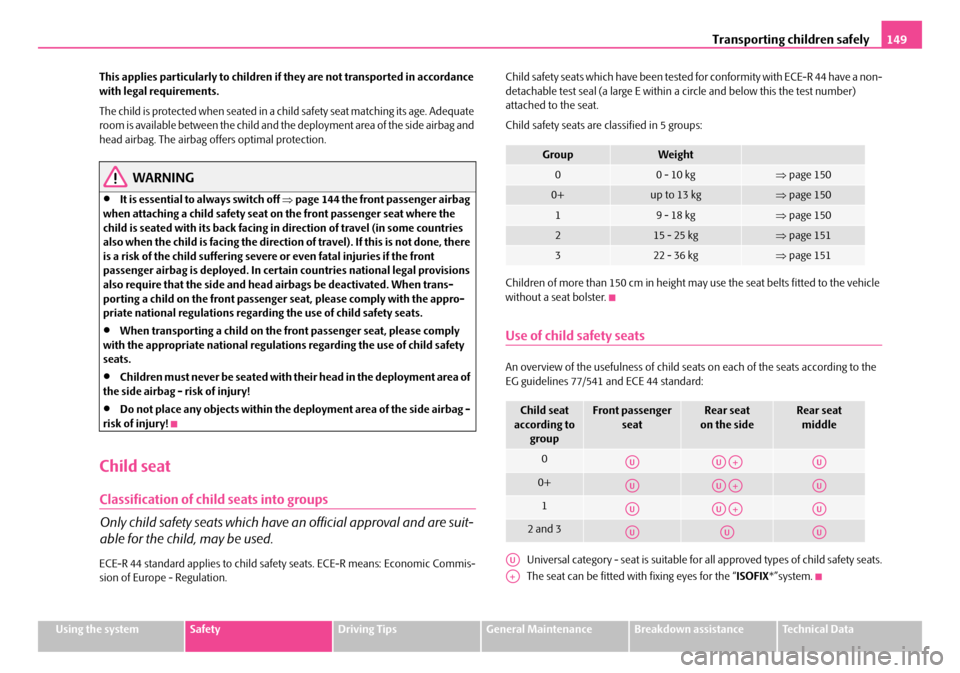
Transporting children safely149
Using the systemSafetyDriving TipsGeneral MaintenanceBreakdown assistanceTechnical Data
This applies particularly to children if they are not transported in accordance
with legal requirements.
The child is protected when seated in a child safety seat matching its age. Adequate
room is available between the child and the
deployment area of the side airbag and
head airbag. The airbag offers optimal protection.
WARNING
•It is essential to always switch off ⇒page 144 the front passenger airbag
when attaching a child safety seat on the front passenger seat where the
child is seated with its back facing in direction of travel (in some countries
also when the child is facing the direction of travel). If this is not done, there
is a risk of the child suffering severe or even fatal injuries if the front
passenger airbag is deployed. In certai n countries national legal provisions
also require that the side and head airbags be deactivated. When trans-
porting a child on the front passenger seat, please comply with the appro-
priate national regulations regarding the use of child safety seats.
•When transporting a child on the front passenger seat, please comply
with the appropriate national regulations regarding the use of child safety
seats.
•Children must never be seated with th eir head in the deployment area of
the side airbag - risk of injury!
•Do not place any objects within the deployment area of the side airbag -
risk of injury!
Child seat
Classification of ch ild seats into groups
Only child safety seats which have an official approval and are suit-
able for the child, may be used.
ECE-R 44 standard applies to child safety seats. ECE-R means: Economic Commis-
sion of Europe - Regulation. Child safety seats which have been tested for conformity with ECE-R 44 have a non-
detachable test seal (a large E within
a circle and below this the test number)
attached to the seat.
Child safety seats are classified in 5 groups:
Children of more than 150 cm in height may use the seat belts fitted to the vehicle
without a seat bolster.
Use of child safety seats
An overview of the usefulness of child seats on each of the seats according to the
EG guidelines 77/541 and ECE 44 standard:
Universal category - seat is suitable for all approved types of child safety seats.
The seat can be fitted with fixing eyes for the “ISOFIX *”system.
GroupWeight
00 - 10 kg⇒page 150
0+up to 13 kg⇒page 150
19 - 18 kg⇒page 150
215 - 25 kg⇒page 151
322 - 36 kg⇒page 151
Child seat
according to groupFront passenger seatRear seat
on the sideRear seat middle
0
0+
1
2 and 3
AUAUA+AU
AUAUA+AU
AUAUA+AU
AUAUAU
AU
A+
NKO B5 20.book Page 149 Friday, March 2, 2007 1:46 PM
Page 151 of 259
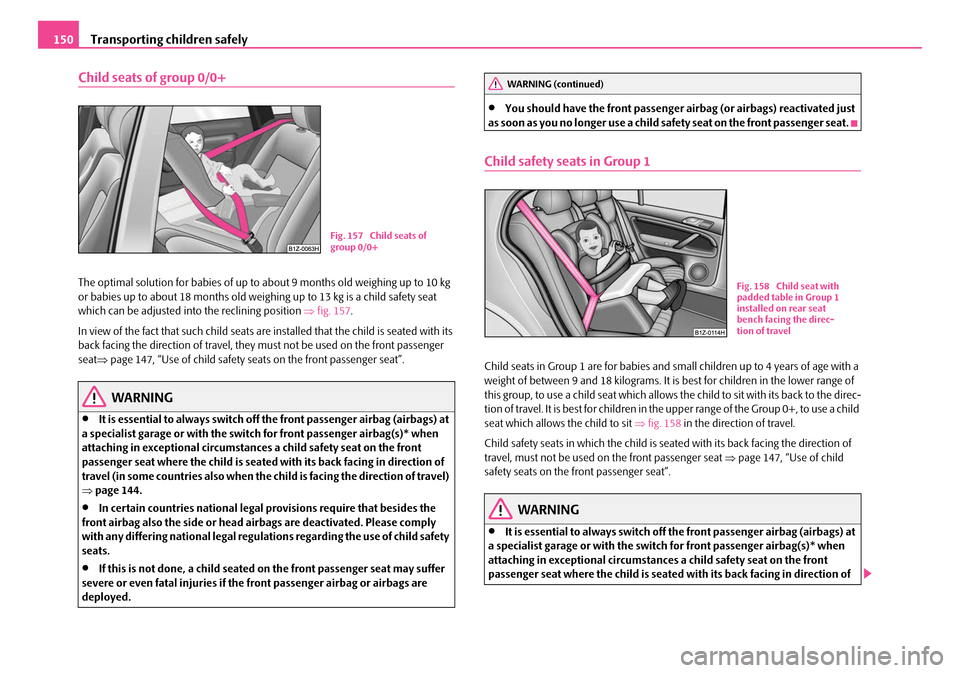
Transporting children safely
150
Child seats of group 0/0+
The optimal solution for babi es of up to about 9 months old weighing up to 10 kg
or babies up to about 18 months old weighi ng up to 13 kg is a child safety seat
which can be adjusted into the reclining position ⇒fig. 157 .
In view of the fact that such child seats are installed that the child is seated with its
back facing the direction of travel, they must not be used on the front passenger
seat ⇒page 147, “Use of child safety seats on the front passenger seat”.
WARNING
•It is essential to always switch off the front passenger airbag (airbags) at
a specialist garage or with the switch for front passenger airbag(s)* when
attaching in exceptional circumstances a child safety seat on the front
passenger seat where the child is seated with its back facing in direction of
travel (in some countries also when the child is facing the direction of travel)
⇒ page 144.
•In certain countries national legal provisions require that besides the
front airbag also the side or head ai rbags are deactivated. Please comply
with any differing national legal regula tions regarding the use of child safety
seats.
•If this is not done, a child seated on the front passenger seat may suffer
severe or even fatal injuries if the front passenger airbag or airbags are
deployed.
•You should have the front passenger airbag (or airbags) reactivated just
as soon as you no longer use a child sa fety seat on the front passenger seat.
Child safety seats in Group 1
Child seats in Group 1 are for babies and small children up to 4 years of age with a
weight of between 9 and 18 kilograms. It is best for children in the lower range of
this group, to use a child seat which allows the child to sit with its back to the direc-
tion of travel. It is best for children in the upper range of the Group 0+, to use a child
seat which allows the child to sit ⇒fig. 158 in the direction of travel.
Child safety seats in which the child is seated with its back facing the direction of
travel, must not be used on the front passenger seat ⇒page 147, “Use of child
safety seats on the front passenger seat”.
WARNING
•It is essential to always switch off the front passenger airbag (airbags) at
a specialist garage or with the switch for front passenger airbag(s)* when
attaching in exceptional circumstances a child safety seat on the front
passenger seat where the child is seated with its back facing in direction of
Fig. 157 Child seats of
group 0/0+
WARNING (continued)
Fig. 158 Child seat with
padded table in Group 1
installed on rear seat
bench facing the direc-
tion of travel
NKO B5 20.book Page 150 Friday, March 2, 2007 1:46 PM